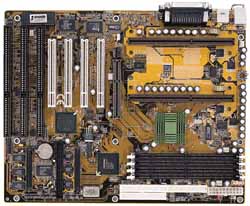The motherboard manufacturer of a thousand faces, if you were to grant this title to any single manufacturer in the industry it would be best molded to the features of Shuttle, a manufacturer that has managed to produce enough motherboards that their user base could be considered to be one of the most diverse in the industry.
Shuttle has manufactured motherboards ranging from low-end Socket-7 and Slot-1/Socket-370 boards to the most competitive of Pentium III ready BX motherboard products, unfortunately, like many other mainboard manufacturers, Shuttle chose to leave out a unique faction of users by producing single processor motherboards alone. For those interested in multiprocessor systems, regardless of their faith in Shuttle, the only option was to pursue the Supermicro, Tyan or maybe even the ASUS offerings of the time.
Shuttle's realization of this weakness in their market concentration inspired the latest addition to the seemingly exponentially growing Shuttle mainboard product line, the HOT-649A. Shuttle has, in the past, won awards and incredible praise and recognition for their efforts on AnandTech among other on-line publications, however how well did the already successful company make the transition from standard desktop motherboards to the high-end multiprocessor world? Let's find out...
New Anand Tech Report Card Rating 83/C+
Do not compare newer ratings to older ones, the newer ratings are much more aggressive
| CPU Interface | Dual Slot-1 |
| Chipset | Intel 440BX |
| L2 Cache | N/A (on-chip) |
| Form Factor | ATX |
| Bus Speeds | 66 / 75 /
83 100 / 103 / 112 / 115 / 120 / 124 133 / 140 / 150 |
| Clock Multipliers | 3.0x - 5.0x |
| Voltages Supported | 1.8v / 2.0v / 2.8v (Auto Detect) |
| Memory Slots | 4 168pin DIMM Slots |
| Expansion Slots | 1 AGP
Slot 4 PCI Slots (4 Full Length) 3 ISA Slots (1 Shared / 3 Full Length) |
| BIOS | Award BIOS |
The Good
| It is a given that as long as you have a multiprocessor Pentium II motherboard, you're going to have a much larger surface area to work with as the PCB size of a Dual Slot-1 motherboard is a dramatic increase over single processor boards. The Shuttle HOT-649A is a pure, albeit manageable, example of this enlarged status. The board still provides a home for the 4/3/1 expansion slot configuration (PCI/ISA/AGP) that has become almost associated with the Shuttle name. The Dual Slot-1 slots are accompanied by the 4 SDRAM DIMM slots, allowing for a maximum of 2GB of system memory to be installed using registered 512MB DIMMs (which happen to be quite pricey), all of which falls into the cacheable memory range provided that you're using Pentium II processors based on the Deschutes core. | |
| The board wouldn't be a complete "high-end" solution if it weren't for the on-board SCSI Shuttle features on the HOT-649A with the Adaptec 7980 controller. The 7980, commonplace on most dual processor boards, allows for an independent 68-pin UltraWide SCSI-3/50-pin UltraSCSI channel and a dedicated 68-pin Ultra2 SCSI channel in order to ensure that Ultra2 drives aren't limited by the presence of older drives on the SCSI chain. |
|
| At a quick glance, the HOT-649A appears to have very few full-length expansion slots, however upon closer examination an interesting approach to the layout of the 649A is revealed. Shuttle positioned the SCSI connectors parallel to the peripheral expansion slots, and purposely placed them in a position shifted downwards and to the right, meaning that they allow for two full length cards to be placed around them without interfering with the cards themselves. | |
Placed along the top edges of both slot-1 interface connectors are rows of electrolytic capacitors, often associated with greater stability depending on their physical location. Shuttle's positioning of the 443BX controller chip nearly flush against the memory banks, separated only by a couple of capacitors, should virtually eliminate the need for an external DRAM buffer when weighing capacitance issues with 4 installed DIMMs. On the opposite side of the slot-1 connectors are two thermal sensors, which form the basis of Shuttle's intelligent monitoring features present on the HOT-649A.
The 649A features Shuttle's latest 150MHz clock generator allowing for FSB speeds of 140/150MHz to be achieved, as well as unique "in-between" settings such as 115MHz and 120MHz for those users that are primarily viewing the 649A as a possible workstation motherboard, with overclocking as a possibility. The FSB settings and clock multipliers can be controlled entirely on the motherboard itself through the use of a few good ol' jumpers (we all remember what those are), however Shuttle does allow for an automatic configuration of the CPU clock multiplier through a single jumper block as with most of their newer BX boards.
Shuttle included a 68-pin Ultra2 SCSI cable with a LVD (Low Voltage Differential) terminator in the 649A bundle, coupling that with the driver disks and CD-ROM for the SCSI controller as well as the motherboard itself, Shuttle tops it all off with their classic Installations Guide pamphlet that documents the meat of the motherboard's features in an easy to reach place.
From a performance perspective, under Windows NT 4, the HOT-649A followed the trend motherboards have produced in the past couple of years, in that its performance stuck to the mean as close as possible. For an evaluation of multiprocessor vs single processor performance under Windows NT take a look at AnandTech's Multiprocessor coverage here.











0 Comments
View All Comments